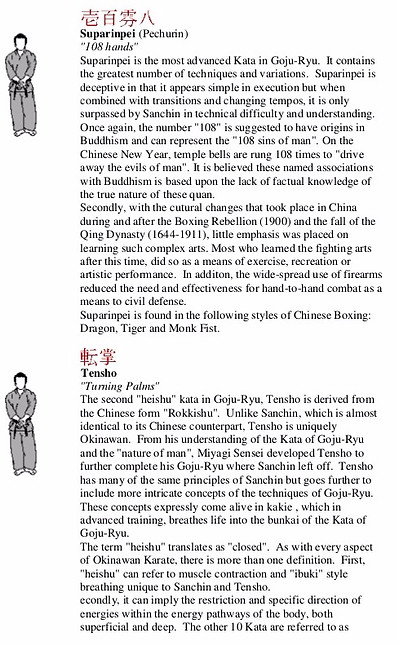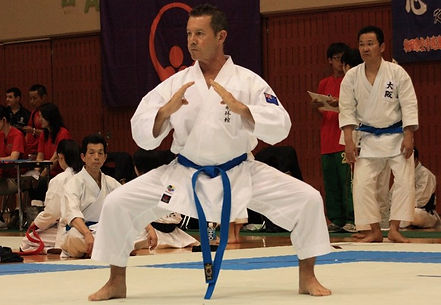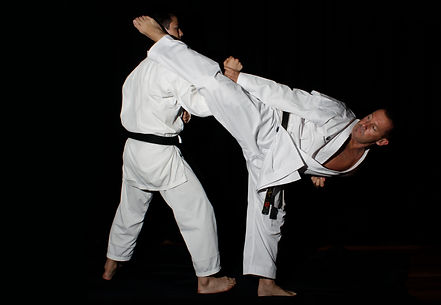 |  |  |
|---|
Atemi Waza (Strikes)
Chudan Zuki - Mid Level Punch
Jodan Zuki - Head Level Punch
Ura Uchi - Front Back Fist
Yoko Ura Uchi - Side Back Fist
Shita Zuki - Short Punch
Age Zuki - Rising Punch
Kagi Zuki - Hook punch
Hijiate - Rising Elbow
Mawashi Hijiate - Round Elbow
Ushiro Hijiate- Reverse Elbow
Ushiro Mawashi Hijiate- Reverse Round Elbow
Shuto Uchi - Knife Hand
Haito Uchi - Ridge Hand
Tetsui - Hammer Fist
Ryo Shotei Ate - Palm Heel Strike
Furi Uchi - Swing Strike
Uke Waza (Blocks)
Jodan Age Uke - Head Level Block
Uchi Uke - Middle Forearm Block
Chudan Uke - Middle Inside Block
Gedan Barai - Downward Block
Gedan Uke - Sweeping Block
Chuge Uke - Double Block
Kake Uke - Hook Block
Mawashi Uke - Round Block
Shuto Uke - Knife Hand Block
Ashi Barai - (Sweeps)
Karate Jutsu - (Throwing)


Tachi Waza (Stances)
Hachji Dachi - Natural Stance
Han Zenkutsu Dachi - Half Front Stance
Zenkutsu Dachi - Forward Stance
Heiko Dachi - Parallel Stance
Heisoku Dachi - Parallel Closed Stance
Musubi Dachi - Open Toes Stance
Neko Ashi Dachi - Cat Stance
Sanchin Dachi - Hour Glass Stance
Shiko Dachi - Sumo Stance
Geri Waza (Kicks)
Kansetsu Geri - Joint Kick
Kin Geri - Groin Kick
Mae Geri - Front Kick
Mawashi Geri - Round Kick
Yoko Geri - Side Kick
Ushiro Geri - Back Kick
Ura Mawashi Geri - Hook Kick
Kansetsu Waza - (Restraints, Joint Locking Techniques , Strangle Holds and Submissions)
A Kata is a pattern of movements which contains a series of attacking and blocking techniques. Kata were created and evolved by previous masters after many years of research, training, and actual combat experience.
Goju Kai Kata originated from Chinese Kung Fu forms which were taught in Okinawa in the 18th and 19th Centuries. Many of the Goju Ryu Kata names are Chinese numbers symbolizing certain Buddhist concepts. For example, the highest Kata in Goju Ryu, Suparinpei meaning the number 108 in Chinese, has a special significance in Buddhism.
Kata is a set of pre-determined movements which consists of defensive and offensive techniques performed in a particular sequence. Each movement and technique in a kata is made up of selected elements suitable to circumstances of real world fighting.
There are 12 Official Kata in Traditional Goju Ryu. Kata is performed alone against imaginary opponents. It serves the purpose of developing good posture, execution of techniques and mental concentration (focus). Each step of Kata needs to be analysed and understood before the Karate practitioner can apply it to real fighting. Kata embeds strategies of fighting designed to expose different parts of the opponent's body and follow-up with offensive techniques.

KATAS
The masters of old created Kata, as a result of experiences in actual fighting, they contracted certain principles in the form of Kata and we have to unlock the code that is within the Kata. Certain ideas cannot be understood by verbal explanation, as much as we will explain people are going to understand it with their own judgment different from one another.
We can use science to explain the dynamic of certain techniques and it is helpful but not enough, the human being is not a machine, and as much as we can imitate the technique, it will be only external. We need to get the feeling of it.
An obvious example is the principle of "feeling, reaction, action, technique one after another, but all together" which means that we don't look to analyze and then react with the proper technique but react by feeling directly through the nervous system in the spine and through accumulated training, this reaction becomes the proper body action and transmission into technique.
So the Kata gives us both physical tools and tuning of the mind into a state of effortless alertness.
Kata is a Means of Freedom of Movement
As much as Kata seems restricted, the goal of Kata is freedom and we can achieve that because Kata is teaching us to conduct our energy in different directions most efficiently, and this efficiency will eventually be brought to any line of movement at any range (we start from big to small) depending on the necessity of the application.
Kata gives us the Ideal
With a strong stimulus like an opponent, we are too busy and excited to correct habits. Training only with partners allows our bad habits to be magnified. So Kata gives us a method to practice and perfect our techniques. Through repetition of kata our bodies learn to react without thought performing with less error.
KUMITE
Kumite is the practice of sparring.
The main types of sparring used in this school of karate-do are pre-arranged sparring, continuous sparring, one handed sparring, sticky hand sparring and free sparring.
Students within this system do not begin sparring until they have successfully passed their Yellow Belt Grading and have already demonstrated a reasonable amount of understanding and control.
Kumite means sparring, and is one of the three main sections of karate training. Kumite is when a Karateka practices skills against an adversary (partner), using the techniques learned from Kihon and Kata.

SPARRING can be No Contact or Semi Contact
(no contact to head) depending on your preference ability and Body Conditioning!
Kumite can be used to develop a particular technique or a skill for example effectively judging and adjusting your distance from your opponent and applying correct timing for effectiveness of your footwork, blocks, strikes and kicks.
Karate training is designed to give its practitioners the ability to deliver devastating power through techniques like punches and kicks. Often the aim of training is that each single strike should be enough to subdue the opponent. However, this clearly would make it difficult to train due to the possibility of injury.
For injury purposes, certain targets are discouraged, for example strikes to the joints and any face contact for low ranks. Many schools prohibit strikes to the groin area.
Goju Karate is renowned for allowing groin strikes. In our Schools these techniques are only permitted with control from Brown belt (3rd Kyu) and above.
HOJU UNDO
Hojo Undo are strength training & conditioning exercises used in some Japanese & Okinawan martial arts, especially by more traditional Karate schools. Hojo Undo is also known as "Supplementary Exercises" or "Supplementary Training". Hojo Undo exercises use specialized equipment such as stone hand weights and gripping jars.
GOJU RYU SEIWAKAI
KIHON (BASICS)
ADVANCED TECHNIQUES
